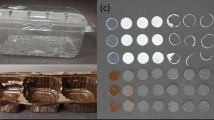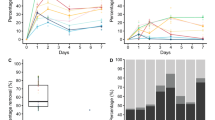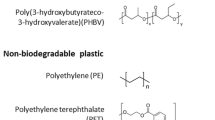Abstract
This study aimed to determine the occurrence and respiration activity of heterotrophic bacteria and fungi in shrimp shell waste and to evaluate the role of chitinolytic bacteria and fungi in its decomposition. The highest levels of bacteria were found in shrimp heads sections and the lowest in exoskeletons. The level of fungi was much lower, with the highest proportion present in heads sections and the lowest in exoskeletons. Chitinolytic bacteria constituted a small percentage of the total heterotrophic bacteria in fresh shrimp waste, averaging 4% in exoskeletons, 2.4% in all parts, and 2% in heads. No chitinolytic bacteria were detected in stored waste. In contrast, the percentage of chitinolytic fungi in shrimp waste was much higher than that of bacteria. Chitinolytic fungi constituted 25–60% of the total fungi in fresh waste and 15–40% in stored waste. Chitinolytic bacteria isolated from heads sections were characterized by the highest chitinolytic activity, averaging 11.2 nmol of methylumbelliferyl · mg−1 protein · h−1, whereas the lowest activity was in strains from exoskeletons, averaging 3.2 nmol of methylumbelliferyl · mg−1 protein · h−1. The chitinolytic activity of fungi isolated from all parts waste, head sections, and exoskeletons was similar. The respiration activity of microorganisms in fresh and stored waste was similar. Oxygen consumption activity increased during incubation and approached a saturation value between days 4 and 5. No correlation between the end value of respiratory activity in the analyzed section of shrimp discard after 5 days and the level of bacteria and fungi was observed. The only significant correlation observed was between the respiratory activity of the shrimp and the level of fungi. The respiration activity significantly depended on the analyzed section of shrimp discard (p < 0.000).



Similar content being viewed by others
References
Alef K (1995) Soil respiration. In: Alef K, Nannipieri P (eds) Methods in applied soil microbiology and biochemistry. Academic press, London, pp 214–219
Arques A, Amat AM, Garcĭa-Ripoll A et al (2007) Detoxification and/or increase of the biodegradability of aqueous solutions of dimethoate by means of solar photocatalysis. J Hazardous Mat 146:447–452
Bradford MM (1976) Rapid and sensitive methods for the quantitation of microgram quantities of protein utilizing the principle of protein-dye binding. Anal Biochem 72:248–254
Cobos MA, Garcia LE, González SS et al (2002) The effect of shrimp shell waste on ruminal bacteria and performance of lambs. Animal Feed Sci Technol 95:179–187
Dechema (1995) Biologische Testmethoden für Böden. 4. Bericht des interdisziplinären Arbeitskreises “Umweltbiotechnologie–Boden.” FRG, Frankfurt
Goossen H, Minnaar RS, Verplanke H (1984) Carbon mineralization in the water of the Grevelelingen as measured with the oxygen consumption method. Neth J Sea Res 18:480–491
Hoppe HG (1993) Use of fluorogenic model substrates for extracellular enzyme activity (EEA) measurements of bacteria [w]: Handbook of methods in aquatic microbial. Ecology [red] Kemp PF, Sherr BF, Cole JJ, Lewis London, pp 509–512
Hufschmid A, Becker-Van Slooten K, Strawczynski A et al (2003) BOD5 measurements of water presenting inhibitory Cu2+: implications in using of BOD to evaluate biodegradability of industrial wastewaters. Chemosphere 50:171–176
Husby FM, Brundage AL, White RL (1981) Utilization of shellfish meals in domestic feeds. Seafood waste management in the 1980s: Conference proceedings. Report 40 Florida Sea Grant College Orlando, FL, pp 230–260
Isermeyer H (1952) Eine einfache Methode zur Bestimmung der Bodenatmung und der Karbonate im Boden. Z. Pflanzenern Bodenk 56:25–38
Jaszkowski K (2001) Chitin could heal. Focus 8(71):25–28
Kim TH, Lee JK, Lee MJ (2007) Biodegradability enhancement of textile wastewater by electron beam irradiation. Radiat Phys Chem 76:1037–1041
Lingappa Y, Lockwood JL (1962) Chitin media for selective isolation and culture of actinomyces. Phytopatology 52:317–323
Liu J, Mattiasson B (2002) Microbial BOD sensors for wastewater analysis. Water Res 36:3786–3802
Martinez J, Smith DC, Steward GF, Azam F (1996) Variability in ectohygrolytic enzyme activities of pelagic marine bacteria and its significance for substrate processing in the sea. Aquatic Microbial Ecol 10:223–230
Matsumoto Y, Saucedo-Castañeda G, Revah S, Shirari K (2004) Production of β-N-acetylhexosaminidase of Verticillium lecanii by solid state and submerged fermentations utilizing shrimp waste silage as substrate and inducer. Process Biochem 39:665–671
McLean MA, Angilletta MJ Jr, Williams KS (2005) If you can’t stand the heat, stay out of the city: thermal reaction norms of chitinolytic fungi in an urban heat island. J Thermal Biol 30:384–391
Mudryk Z (1991) The role of heterotrophic bacteria in the decomposition processes of some macromolecular compounds in the estuarine Gardno Lake. Pol Arch Hydrobiol 38:153–162
Mudryk Z, Skórczewski P (2004) Extracellular enzyme activity at the air–water interface of an estuarine lake. Estuarine Coastal Shelf Sci 59:59–69
Nicol S (1991) Life after death for empty shells. New Sci 129:46–48
O’Malley LP (2006) Evaluation and modification of the OECD 301 F respiratory biodegradation test method with regard to test substance concentration and inoculum. Water Air Soil Pollution 177:251–265
Patidar P, Agrwal D, Banerjee T, Patil S (2005) Optimisation of process parameters for chitinase production by soil isolates of Penicillium chrysogenum under solid substrate fermentation. Process Biochem 40:2962–2967
Paul EA, Clark FE (2000) Microbiology and biochemistry of soil. Wydawnictwo Uniwersytetu Marii Curie–Skłodowskiej Lublin
Platen H, Wirtz A (1999) The measurement of respiration activity soil with a respirometric method (measuring system Oxi Top Control). WTW/OxiTop®/Appliance
Podgórska B (2002) The role of bacteria in transformation of organic matter of sandy beach ecotones of the Baltic sea. Doctoral thesis. Institute of Oceanography PAN (Polish Academy of Science), Sopot
Ramĭrez-Coutiño L, Marĭn-Cervantes MC, Huerta S et al (2006) Enzymatic hydrolysis of chitin in the production of oligosaccharides using Lecanicillum fungicola chitinases. Process Biochem 41:1106–1110
Rattanakit N, Plikomol A, Yano S et al (2002) Utilization of shrimp shellfish waste as a substrate for solid-state cultivation of Aspergillus sp. S1–13: Evaluation of a culture based on chitinase formation, which is necessary for chitin assimilation. J Biosci Bioeng 93:550–556
Sachindra NM, Bhaskar N, Siddegowda GS et al (2007) Recovery of carotenoids from ensilaged shrimp waste. Bioresource Technol 98:1642–1200
Sroka E, Kamiński W, Bohdziewicz J (2004) Biological treatment of meat industry wastewater. Desalination 162:85–91
Swiontek Brzezinska M, Lalke-Porczyk E, Donderski W (2007) Chitinolytic activity of bacteria and fungi isolated from shrimp exoskeletons. Oceanological Hydrobiological Stud 36:101–111
Swiontek Brzezinska M, Lalke-Porczyk E, Donderski W (2008) Utilization of shrimp waste as a respiration substrate by planktonic and benthic microorganisms. Polish J Environ Stud 17:273–282
Swiontek Brzezinska M, Lalke-Porczyk E, Donderski W (2008) Shrimp waste as a respiration substrate for soil microflora of the Chełmżyńskie Lake watershed. Polish J Natural Sci 23:164–177
Vähäoja P, Kuokkanem T, Välimäki I et al (2005) Biodegradabilities of some chain oils in groundwater as determined by the respirometric BOD OxiTop method. Anal Bioanal Chem 381:445–450
Wang SL, Huang JR (2001) Microbial reclamation of shellfish waste for the production of chitinases. Enzyme Microb Technol 28:376–382
Wang SL, Shih IL, Liang TW, Wang CH (2001) Purification and characterization of two antifungal chitinases extracellularly produced by Bacillus amyloliquefaciens V 656 in a shrimp and crab shell powder medium. J Agric Food Chem 50:2241–2248
Wang SL, Lin TY, Yen YH et al (2006) Bioconversion of shellfish chitin wastes for the production of Bacillus subtilis W–118 chitinase. Carbohydrate Res 341:2507–2515
Watkings BE, Adir J, Oldfield JE (1982) Evaluation of shrimp and king crab processing byproducts as feed supplement for mink. J Animal Sci 55:578–579
WTW (1998) Applikationsbericht BSB 997 230: Respirometrische BSB5-Bestimmung von häuslichem Abwasser mit dem OxiTop® Control–oder OxiTop®- Messystem. Wissenschaftlich-technische Werkstätten (WTW), Weilheim
Zdanowski M, Zmuda MJ, Zwolska I (2005) Bacterial role in the decomposition of marine-derived material (penguin guano) in the terrestrial maritime Antarctic. Soil Biol Biochem 37:581–595
Acknowledgments
The authors thank Kszysztof Kitewski, Marian Rudnicki, and the employees of Krymar for providing the material for the analyses. The research program was financed from KBN grant no. 2PO4G06329.
Author information
Authors and Affiliations
Corresponding author
Rights and permissions
About this article
Cite this article
Brzezinska, M.S., Lalke-Porczyk, E., Donderski, W. et al. Occurrence and Activity of Microorganisms in Shrimp Waste. Curr Microbiol 57, 580–587 (2008). https://doi.org/10.1007/s00284-008-9246-1
Received:
Revised:
Accepted:
Published:
Issue Date:
DOI: https://doi.org/10.1007/s00284-008-9246-1




